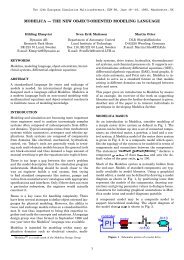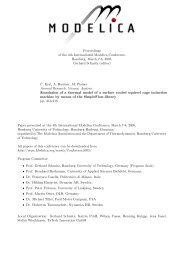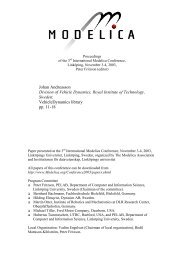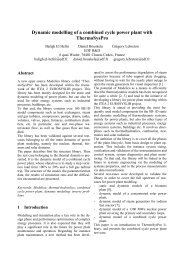Integration of CasADi and JModelica.org - Automatic Control
Integration of CasADi and JModelica.org - Automatic Control
Integration of CasADi and JModelica.org - Automatic Control
Create successful ePaper yourself
Turn your PDF publications into a flip-book with our unique Google optimized e-Paper software.
model exchange format previously reported in [32].<br />
Two main results are presented in the paper. Firstly,<br />
it is shown how <strong>CasADi</strong>, supporting import <strong>of</strong> the<br />
mentioned XML model format, has been used to integrate<br />
<strong>JModelica</strong>.<strong>org</strong> with ACADO Toolkit. Secondly,<br />
a novel direct collocation method has been developed<br />
based on the innovative symbolic manipulation features<br />
<strong>of</strong> <strong>CasADi</strong>. From a user’s perspective, both<br />
<strong>CasADi</strong> <strong>and</strong> <strong>JModelica</strong>.<strong>org</strong> come with Python interfaces,<br />
which makes scripting, plotting <strong>and</strong> analysis <strong>of</strong><br />
results straightforward.<br />
The benefit <strong>of</strong> integrating additional algorithms for<br />
solution <strong>of</strong> dynamic optimization problems in the<br />
<strong>JModelica</strong>.<strong>org</strong> platform is that users may experiment<br />
with different algorithms <strong>and</strong> choose the one that is<br />
most suited for their particular problem. To some extent,<br />
the situation is similar to that <strong>of</strong> choosing an integrator<br />
for a simulation experiment, where it is well<br />
known that stiff systems require more sophisticated<br />
solvers than non-stiff systems.<br />
The paper is <strong>org</strong>anized as follows: in Section 2,<br />
background on dynamic optimization, Modelica <strong>and</strong><br />
Optimica, ACADO <strong>and</strong> <strong>JModelica</strong>.<strong>org</strong> is given. Section<br />
3 describes <strong>CasADi</strong> <strong>and</strong> recent extensions there<strong>of</strong>.<br />
Section 4 reports a novel Python-based collocation implementation<br />
<strong>and</strong> in Section 5, benchmark results are<br />
presented. The paper ends with a summary <strong>and</strong> conclusions<br />
in Section 6.<br />
2 Background<br />
2.1 Dynamic optimization<br />
Dynamic optimization is the solution <strong>of</strong> decision<br />
making problems constrained by differential or<br />
differential-algebraic equations. A common formulation<br />
is the optimal control problem (OCP) based on<br />
differential-algebraic equations (DAE) on the form<br />
T<br />
min<br />
x,u,z,p 0<br />
l(t,x(t), ˙x(t),z(t),u(t), p)dt<br />
+ E(T,x(T ),z(T ), p)<br />
subject to<br />
f (t,x(t), ˙x(t),z(t),u(t), p) = 0 t ∈ [0,T ]<br />
h(t,x(t), ˙x(t),z(t),u(t), p) ≤ 0 t ∈ [0,T ]<br />
x(0) = x0<br />
umin ≤ u(t) ≤ umax t ∈ [0,T ]<br />
pmin ≤ p ≤ pmax<br />
(1)<br />
where x ∈ R Nx <strong>and</strong> z ∈ R Nz denote differential <strong>and</strong> algebraic<br />
states respectively, u ∈ R Nu are the free con-<br />
trol signals <strong>and</strong> p ∈ R Np a set <strong>of</strong> free parameters in the<br />
model. The DAE is represented by the Nx + Nz equations<br />
f (t,x(t), ˙x,z(t),u(t), p) = 0, with the initial value<br />
for x explicitly given.<br />
The objective function consists <strong>of</strong> an integral cost<br />
contribution (or Lagrange term) <strong>and</strong> an end time cost<br />
contribution (or Mayer term). The time horizon [0,T ]<br />
may or may not be fixed.<br />
Numerical methods for solving this optimization<br />
problem emerged with the birth <strong>of</strong> the electronic computer<br />
in the 1950’s <strong>and</strong> were typically based on either<br />
dynamic programming, which is limited to very<br />
small problems, or methods based on the calculus<br />
<strong>of</strong> variation, so-called indirect methods. The inability<br />
<strong>of</strong> indirect methods to deal with inequality<br />
constraints, represented above as the path constraint<br />
h(t,x(t), ˙x,z(t),u(t), p) ≤ 0 <strong>and</strong> the control bounds<br />
u(·) ∈ [umin,umax], shifted the focus in the early 1980’s<br />
to direct-methods, where instead the control, <strong>and</strong> (possibly)<br />
the state, trajectories are parametrized to form<br />
a finite-dimensional non-linear program (NLP), for<br />
which st<strong>and</strong>ard solution methods exist. In this work,<br />
we employ two <strong>of</strong> the most popular methods in this<br />
field, namely direct multiple shooting <strong>and</strong> direct collocation,<br />
see [8, 9] for an overview.<br />
2.1.1 Direct multiple shooting<br />
After parametrizing the control trajectories, for example<br />
by using a piecewise constant approximation, the<br />
time varying state trajectories can be eliminated by<br />
making use <strong>of</strong> st<strong>and</strong>ard ODE or DAE integrators. This<br />
method <strong>of</strong> embeddding DAE integrators in the NLP<br />
formulation is referred to as single shooting. The advantage<br />
is that it makes use <strong>of</strong> two st<strong>and</strong>ard problem<br />
formulations, the solution <strong>of</strong> initial value problems for<br />
DAEs <strong>and</strong> the solution <strong>of</strong> unstructured NLPs. For both<br />
<strong>of</strong> these problems, there exist several st<strong>and</strong>ard solvers,<br />
facilitating the implementation <strong>of</strong> the method. The<br />
drawback <strong>of</strong> single shooting is that the integrator call<br />
is a highly nonlinear operation, even if the differential<br />
equation is a linear one, making the NLP-optimizer<br />
prone to ending up in a local, rather than global, minimum<br />
<strong>and</strong>/or to slow convergence speeds To overcome<br />
this, Bock’s direct multiple shooting method [10] includes<br />
in the optimization problem the differential<br />
state at a number <strong>of</strong> points, ”shooting nodes”, <strong>and</strong> the<br />
continuity <strong>of</strong> the state trajectories at these points is enforced<br />
by adding additional constraints to the NLP.<br />
These additional degrees <strong>of</strong> freedom can be used for<br />
suitable initialization <strong>of</strong> the state trajectories <strong>and</strong> <strong>of</strong>ten<br />
increase the radius <strong>of</strong> convergence at the cost <strong>of</strong> a
















